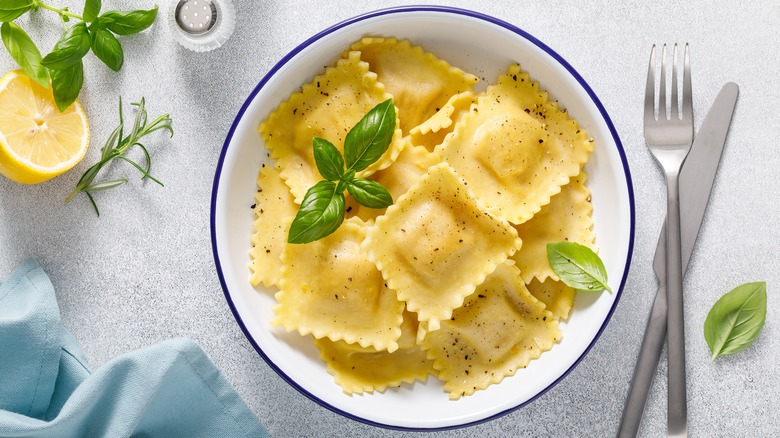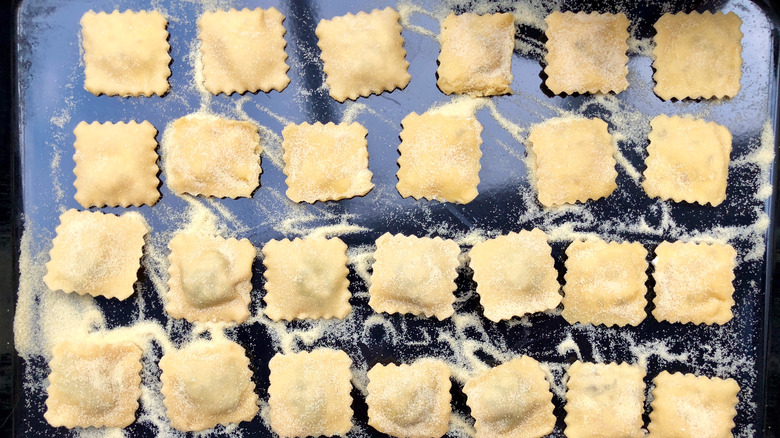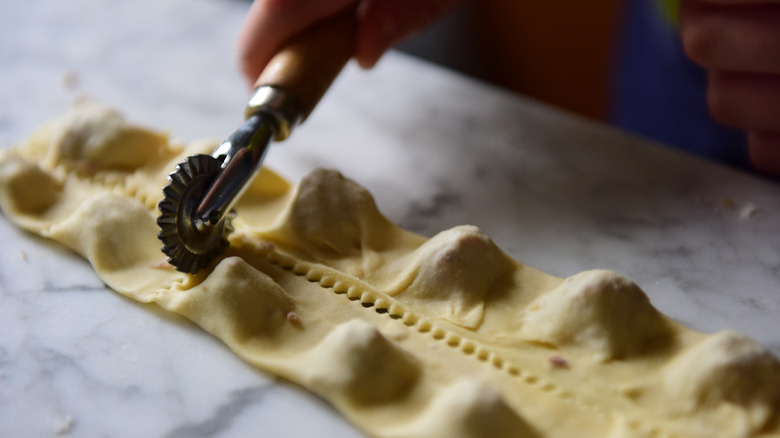The Biggest Mistake You're Making When Cooking Ravioli
If there's one type of pasta that should be considered a top comfort food, it's ravioli. A delicious filling wrapped in a soft, pillowy pasta dough and served with browned butter and sage or creamy Alfredo sauce might just be what dreams are made of. The feeling of ravioli melting in your mouth is like no other, and can make a bad day a little bit better.
Whether you're making your own dough or using a frozen version, you're not alone if you've struggled with the ravioli sticking together as it boils. Although this might be the perfect way to accidentally add more delicious pasta to your plate, stuck ravioli will usually break or tear, and that means wasted filling. The best way to avoid this? Don't overcrowd your ravioli. Cooking too many pieces at once will cause the pasta to stick together and possibly break, so it is best to make ravioli in small batches. If you want the edges to remain sealed and the filling to stay inside, giving the pasta enough space is key.
Avoid overcrowding your ravioli
In a large pot, add 4 to 6 quarts of water and bring to a boil, then add a heaped teaspoon of salt before carefully dropping in your first batch of ravioli. If you're unsure how many pieces will fit comfortably in your pot, it is always better to start with less and add more if there is room. Make sure that each piece has enough space to cook without touching the others. Once the pasta floats to the top, your ravioli is ready. You can use the same boiling water to cook your next batch of pillowy pasta.
Keep in mind that fresh homemade ravioli will only take a few minutes, while store-bought or frozen varieties need to cook longer. Be sure not to overcook them because, surprise, this can also cause your ravioli to stick. If you're not planning on serving the ravioli immediately after cooking, one great hack for making pasta is to drizzle a small amount of olive oil over the cooked batch to keep it from sticking together as it cools.
If you're baking or air-frying your ravioli instead, spread the pasta in a single layer on a baking sheet without any pieces touching to ensure mess-free and even cooking. This is also a great way to guarantee that each ravioli piece gets perfectly crispy and golden.
Other tips for the best ravioli
Overcrowding your ravioli won't do the pasta any favors, and a few other issues should be avoided when it comes to these pillowy pieces. As you're cooking your pasta, let the water boil gently rather than aggressively. This will stop the pieces from knocking into each other and potentially sticking or tearing. In fact, gentle is always the way to go when handling ravioli. Be careful when lowering the pieces into the water, as well as when taking them out. This will ensure the delicious fillings stay where they belong.
If you're making fresh pasta dough, then be sure not to overfill the pasta squares. Overstuffed ravioli has a tendency to burst when cooking, so stick to a consistent measurement like a teaspoon or so to make sure you don't overdo it. Another trick is to seal the dough around the filling before working outward toward the edges. This ensures there are minimal air bubbles and no popped pasta while cooking. Dab the edges with a little water before sealing shut to keep your ravioli perfectly intact.
Filling and sauce options are plentiful, and with these tricks your ravioli will be a success, with each bite a flavorful explosion. Think further than spinach and ricotta filling, and fill your ravioli with vegetables like mashed sweet potato, pumpkin, or broccoli. You could also add the ravioli to a soup instead of a sauce, taking your cozy comfort meal to a new level.


